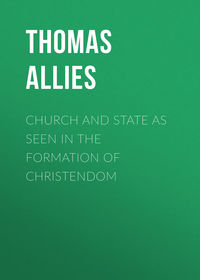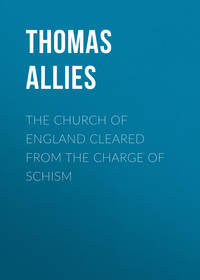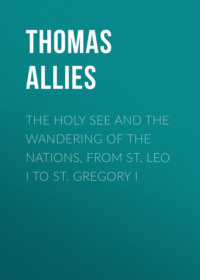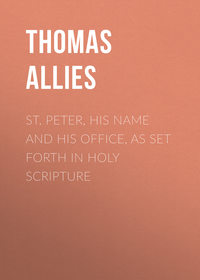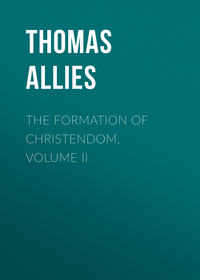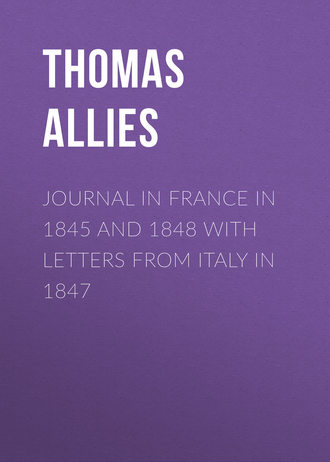 полная версия
полная версияJournal in France in 1845 and 1848 with Letters from Italy in 1847
She is said to spring up again into her former position, as often as her state of ecstacy comes upon her, without disjoining her hands; and this we should have liked to see, but the friar was urgent that we should leave, and we accordingly obeyed. The sleeves she wore round her wrists prevented our being able to see whether the stigmata were visible, which she bears on her hands and on her feet. The Bishop of Trent afterwards told me we should have asked the confessor to order her to show us the former. These were first observed in 1834. Now, though what we saw bears out the accounts given of the Estatica so far as it went, yet I must admit that we did not leave her with that full satisfaction we had felt in the case of the Addolorata. Maria Mörl's state in its very nature does not admit the bystander to such perfect proof as that of Domenica Lazzari. Had we remained half an hour or an hour instead of six minutes, it must still have been a matter of faith to us how long these ecstacies continue, and how often they recur. None but those who live daily with her can be aware of all her case. I can only say that what we saw was very strange and very striking, and when the Bishop of Trent informs us, as he did, a few hours ago, that these trances continue four or five hours together, I must entirely believe it. He had seen the stigmata on her hands, and she had rendered him, as her superior, the same obedience which she gives to her confessor. If I may venture to draw any conclusion from what I have seen, it is, that it appears to be a design of God, by means of these two young persons, to impress on an age of especial scepticism and unbelief in spiritual agency such tokens of our Lord's Passion, as no candid observer can fail to recognise. Neither of these cases can be brought under the ordinary laws of nature; both seem to bear witness in a different, but perhaps equally wonderful manner, to the glory of God as reflected from the Passion of His Son on the members of His Body.
Ever yours,T. W. Allies.P.S. Maria Domenica Lazzari died about Easter, 1848, aged thirty-three years.
Albergo dell' Europa, Trent,Aug. 1. 1847.My dear – .
I do not know whether I said anything about writing to you before I left England, but I feel persuaded that you must be sufficiently interested in our peregrinations to justify me in inflicting a letter upon you. P. tells me he wrote from Paris, up to which time he has doubtless given you full particulars, and from which point I shall take up the chronicle of our movements. We left Paris on the 9th of July, after having been much pleased and interested by what we had seen there, and came by a forced march (and in hot weather a severe one) in the malle poste to Lyons on S. Irenæus' Day, but, by an unfortunate delay, too late to see the archbishop officiate in the church, and according to the rite of his patron and predecessor. At Lyons we took the Rhone, and steamed to Avignon (the scenery quite equal in my opinion to that of the Rhine), where we stayed for four hours, endeavouring, in spite of heat and some fatigue, to call up visions of French popes, disconsolate Petrarch, or the devout Laura with her green gown and well bound missal gliding towards the church of St. Clair. At last we were hurried off to Aix, and finally to Marseilles, where we just hit upon the moment of departure of the Neapolitan packet, which after coasting along the beauties of the Cornice road landed us at Genoa, where we pitched our tent to rest for a few days. We had a letter to Padre Giordano at the Jesuits' College. He began by a most polemical conversation with Allies on the "Tu es Petrus," &c., but afterwards dropped the subject altogether; he was exceedingly civil, offered us every information we needed, and gave us access to every thing we wanted to see. In this manner I found Genoa far more interesting than I had expected. It is a most beautiful and most Italian city, and has, as to outward appearance, lost nothing of its character in the days of the republic; and its institutions for the support and relief of the poor, the sick, and the religious, gave an additional source of interest beyond that for which I was prepared. From Genoa we came by Pavia to Milan, where we staid five days: for a city so celebrated and so important in ancient times it is remarkable and much to be regretted that its ancient character is so completely lost. Milan is now quite a modern city, with the exception of a very few solitary buildings; the cathedral itself, wonderful as a structure, and beautiful to the end of the chapter, is quite indefensible in the eyes of a thorough-going Goth, and is after all only a very successful vagary of a bastard style. The beauty of the material, the exquisite finish of the sculpture, and fine proportions of individual parts, with the costly and vast effect of the whole, do however quite disarm one's critical inclinations, and the interior is (as we saw it on Sunday last with the choir filled by the scarlet robes of the chapter of the cardinal see, and the nave almost filled by people of every sex and station,) one of the grandest I know, and loses nothing by its intimate connection with S. Charles Borromeo, who, by the way, appears to me to have been among the best of the reformers of the 16th century. St. Ambrose's Church still remains, though I should think little, with the exception of a few minor ornaments, belonged to his time, beyond the atrium, the pulpit, and bishop's chair. The valves of the door from which he repelled the emperor are also here, though at the time they belonged to another church. They show a spring in which S. Augustine's baptism is said to have been performed, and also the garden mentioned in the "Confessions" as having been the scene of his conversion; but for these two I do not think they claim more than a great probability, and entire accordance with all that is known on the subject, the tradition of the actual spots having been lost, and only recovered two or three centuries ago. From Milan we made an expedition to this place in order to see the two wonderful phenomena of which Lord Shrewsbury wrote an account some years ago, – the Estatica and Addolorata. We left Milan on Monday, and had a fine sub-alpine drive to Desenzano on the Lake Garda, with which we were very much pleased, and up which we steamed to Riva; from thence to Trent, where we introduced ourselves to the bishop as three Oxonian priests and professors, begging his highness (he is prince-bishop) to give us letters to Caldaro, as the Estatica is only visible on this being granted. He received us with all possible courtesy, and instantly gave us the necessary introduction, begging us to lay before him our impressions of the matter on our return here: he talked much of Wiseman, Newman, and Pusey, making the admission with regard to the latter that "scrive come Cattolico." He told us he was himself by birth a German, and that Englishmen were especially welcome to him as countrymen of St. Boniface, the apostle of his native country. We left Trent for Neumarkt, twenty miles distant, on Wednesday, and on Thursday passed over some very fine Tyrolese mountain scenery to Cavalese, where we had an introduction to the physician of the place, who has always attended the Addolorata since the commencement of her malady, (and this we had through the kindness of Manzoni's step-son, whom we had met at his house in Milan, – it was no small satisfaction to me to meet the author of "Promessi Sposi," &c.) and with whom we walked over to Capriana, about twelve miles distant, where Domenica Lazzari abides. I think her case such a supernatural portent, and, it may be, one of such deep interest to members of the Church, that I shall fill the other side of the sheet with such an account of her as I have room for. Maria Domenica Lazzari is thirty-two years of age, the daughter of a poor miller in Capriana, one of five children, a sister unmarried with whom she lives, both parents being dead, a sister married in the village, and two brothers, who do not bear a very high character. She herself from childhood was very virtuous and pious, extremely attentive to all active duties, and worked like other girls, though always remarkable both for natural cleverness and her attention to religion. In 1833 she was attacked by an intermittent fever, which left her extremely weak, and after which pains were felt by her in her hands, feet, and head; in April, 1834, she for the last time drank some water and ate a piece of bread, since which time she has never eaten nor drunk except in partaking of the Blessed Sacrament. In the same year she received the stigmata, which are most evident and apparent, and from which a large quantity of blood flows every Friday without exception, and on no other day. It was in order to test this that we contrived that our arrival should take place on a Thursday, repeating our visit on the following day. We arrived at Capriana about five in the evening, and went at once to her house, which is a little peasant's cabin chiefly built of wood, in the outskirts of the village, her only attendant being her elder sister, a simple unsophisticated peasant girl. We found her lying in great suffering in a bed about the length of a child's crib, a contraction of the muscles having followed upon her illness, and reduced a formerly tall person to the length of about three feet. At first she was unable to speak to us, but our companion (her physician) fanned her for some time with a large fan, which seemed to relieve her, and in a little time she revived. While she lay in this state I examined her very closely. The stigmata are most evident on both sides of the hands, and in a very regular circle round the forehead; these were perfectly dry, the hands being white and clean with the exception of the actual punctures of the stigmata, which are about the size of a silver fourpence, the wounds of the forehead being such as a penknife might have made; and the blood which had flowed on the previous Friday was dry, and covered her face as low as the upper part of the nostril, giving all the appearance of a blood-stained mask, the blood in this case not following the inclination of her present recumbent position, but, (as is the case also in the wounds on the feet,) following the lines it would take in a pendent posture. The costal wound is on her left side. We staid in the room about three-quarters of an hour, and then retired; we returned at five o'clock the next morning, and found her much better, the wounds on the forehead and hands were all open, and blood exuding from all: she talked with greater ease than she had done before. She begged us to take her salutations to the Bishop of Trent, to beg for his blessing upon her, and his intercession for her with the "Bishop of all;" "and I," she said, "in my turn will pray for his highness as much as I am able." We commended ourselves and all England to her prayers, telling her that now there were many religions in England, but that we should pray that all might be one: her answer was, "E una religione sola, Cattolica, Romana, fuori di questa non si deve aver speranza" (this I should think came from her catechism). She said all the English she had seen had given her the same account of their country, and promised to pray both for us and for England "quanto io posso." We saw her confessor for a few minutes, and I wish we could have had some conversation with him, but he was just starting to pay his brother a visit at the bottom of the valley, and we would not detain him. In the course of conversation with Mr. Yoris, and the natives of Capriana and the neighbourhood, we gained many other facts connected with her which I have not room for here; this will convey to you some notion of this most extraordinary portent, of the supernatural character of which any eye witness would, I am sure, do violence to his reason and judgment by doubting, and which physicians, philosophers and bishops have all agreed in asserting as being without explanation according to physical laws, and which I can look at in no other light than as a representation, vouchsafed for the edification of the Church and warning of sinners, of the Passion of the Son of God. The supernatural points in her case I take to be: 1. her existing for more than thirteen years without food, during which time the nails, hair, &c., have continued to grow; 2. the reception of the five wounds; 3. the periodical effusion of a quantity of blood on every return of the day of our Lord's Passion: 4. the course taken by the blood flowing from the wounds, quite at variance with the natural law of fluids. We have, I assure you, been very much impressed by this case, and what to me makes it the more peculiar is, that, in former cases in which the stigmata have been granted, they have appeared (as in the cases of S. Francis of Assisi, S. Theresa, or S. Catherine) as the seal of consummate sanctity, or the reward of intense meditation on the subject of the Passion, whereas in the present instance there is nothing to lead one to suppose either one or the other, in any extraordinary degree. The impression conveyed to me by my visit was, I confess, very considerable, though it was more one of great suffering and resignation, than of any extraordinary tokens of grace, in the object of our visit. There is, I take it, no necessary connection between the extraordinary phenomena which her body bears and extreme sanctity, though one might expect it. Her life has always been extremely virtuous and pious, (the country people spoke of her as "bonissima ragazza"), and her long and intense suffering appears to have chastened and subdued her spirit to a state one would consider well disciplined to meet death, but nothing that I saw led me to suppose the lofty religious abstraction, the spiritual fervour, or super-human yearning of the soul for God, which one looks for in the female saint. Far be it from me to pry into the Divine intentions in this extraordinary appearance which we have witnessed, but if He who does all things to bring back our erring race to Himself destines her merely to be a living representation of the sufferings of the Son of God (and to serve no higher purpose than that for which we should erect a crucifix), men of faith will not fail to derive benefit to their souls, amidst their thanks for a token of the divine goodness, in contemplating this memento of our Lord's Passion, while it may serve in some cases, we may hope, to warn the scornful that a day will come when they will in like manner have to "look on Him whom they pierced."
I have not yet spoken to you of the Estatica, whom we saw yesterday; and though I cannot say that her case may not be equally interesting, yet as its details are taken more from credit, I have the less to say from personal investigation.
Maria Mörl is the daughter of a nobleman of Caldaro, whose fervour in devotion has gradually grown to ecstasis, and an entire abstraction from the world, and constant continuance in what the spiritual writers call the "unitive" life: the ecstasis continues from four to five hours at a time, and only ceases from bodily weakness, or at the command of her confessor. She converses with her spiritual directors and superiors alone, rarely eats, her only sustenance being occasionally a morsel of bread and a few grapes. She has been in this state for years, and lives in and upon incessant acts of devotion. She is kept very close and retired in a Franciscan convent, and none are allowed to see her without a letter from the bishop. We found her as she had been described to us, wrapt in the most complete ecstasis, and certainly, as a representation of a devotional figure, nothing could be more striking or more beautiful; but as, from the very nature of the case, her ecstasis must cease by communication with the visible world, it was to us nothing more than a spectacle. I have room, however, for no more, and must have already wearied you with this epistola Tridentina, at the length of which I am ashamed. We have just been to the bishop, who has been most courteous and obliging, and given us several facts connected with the above mentioned. This place is a most comely city; the hills of Tyrol stand about it, ὥσει θέατρον, with snowy peaks beyond them, and the Adige comes rolling from the mountains an "exulting and abounding river." I cannot help thinking what delightful "constitutionals" the dons of 1545 must have had after their hot work in the council. Excuse prolixity, and
Believe me ever yours,John H. Wynne.Hotel Europa, Trent, August 1. 1847.My dear – .
*** From Milan we went to Desenzano, to begin an expedition to see a very great wonder in the Tyrol, of which I must give you an account. We went by the Poste to Desenzano, the southern point of the lake of Garda, and from thence steamed all up that most beautiful sheet of water to Riva. From Riva we took a ricketty machine, called by courtesy the Post, to Roveredo, and on hither to Trent. First I must tell you, we had an introduction to Manzoni at Milan from a friend in Paris; and his son-in-law had just returned from seeing one of the two persons who were the object of our present pilgrimage – the Addolorata and the Estatica, whose case was set forth, some few years ago (about three or four), by Lord Shrewsbury. The first of these has received the stigmata of the Passion, from which blood issues every Friday – the crown of thorns, the nail-holes in the hands and feet, and the wound in the left side; and the second lives in a continual trance. We met a lady in Paris, a Roman Catholic, who had seen them, and spoke much about both, but not very satisfactorily to our minds. We determined accordingly, if possible, to visit them ourselves, and received full instruction from Signor Stephano Stampa at Milan as to the route and all other needful circumstances. Well, at Trent we went to the bishop; for one of these persons, Maria Mörl, the Estatica, lives in a convent, and may not be seen without a letter from the bishop, which we hardly expected would be granted to any persons not Romans. However, we wrote Artium Magister, Oxford, upon our cards, and sent them in. He received us very politely, granted at once the petition for a letter, begged us, if possible, to call on him and give him our opinion on the cases in returning; "for," said he, "we cannot pronounce about either case, especially the Estatica, while they live, and the end is uncertain;" and he further thought every one who had the opportunity should make an unfettered judgment for themselves. At the conclusion of the interview he gave us his blessing, and by noon we were on our way in an omnibus to Neumarkt, up the valley of the Adige; grand castellated rocks overgrown with brushwood, some 12 or 1700 feet, on either side of this rapid river. Neumarkt is a stupid little place; and we were considerably imposed upon by the worthies there, who might have put us at once in the way to our point. Next morning, Thursday, 29., we took a carriage to Cavalese, a small town in the mountains, a post and a half distant; and after breakfast there, we found out Signor Yoris, a medico, to whom Signor S. Stampa had given us a letter of introduction. He was very civil, and offered to accompany us to the village of the Addolorata, whose name is Domenica Lazzari. This place is called Capriana, and we walked thither in something less than four hours, a distance (I supposed) of about nine or ten miles. This was across a range of hills, and up the valley of a tributary to the Adige: the hills covered with forests of spruce and pine, and very beautiful. We got to Capriana about 5 P.M.; and I will give you an abridgment of notes I wrote that evening for the rest of the account. Reached Capriana at five, turned to the right to the house – almost the outside of all, the meanest we saw – and after some minutes the sister arrived and let us in. The room at first dark, too dark to see more than the figure contracted in the bed, and the face dark with blood as low as the bottom of the nose, and a little lower on each side. The medico drew aside the curtain, and we saw plainly the stigmata on the back of the hand, and the marks round the forehead in a straight line, about an inch below the hair in the middle. The marks are about a quarter of an inch apart in an even row as far as the hair, and for three or four marks under it. The medico told me they go all round. There were other marks below the first down to the eyebrows, but whether so regular as the first I could not tell for the quantity of blood clotted and dried on the face. The blood has flowed straight towards the bottom of the face, and not trickled sideways to the bed. There has been a good deal this week. The hands, which are much wasted, are clasped continually on the top of the bed clothes, and are marked a little above the centre with the stigmata (the nail holes); the scar extends half or three quarters of an inch all round, slightly red. The wound is cicatrised with a dark spot of dried blood in the centre. Inside (as well as I could see, the hands being clasped,) the left palm seems to have a long white wound right into the flesh, which is covered all round with dried blood. That on the face is so dark and continual, that, from the holes of the spicæ (thorn marks) to the nose, it is just like a dark mask. Her breast is curved up to a close convex, and the legs drawn up till almost doubled from convulsions. The medico says she was once as tall as I am. Twelve or thirteen years since she has eaten anything but the Blessed Sacrament, and that in the most minute portions possible.
The following are the correct dates: —
10th April, 1834. Nothing eaten since.
10th January, 1834. Stigmata, hands, feet and side.
31st January, 1834. Crown of thorns.
An altar is in the room, at which the bishop allows mass to be celebrated once or twice every week, according to the convenience of the priest, and on saints' days.
We spoke of the bishop. She was much interested also in all that the doctor said. He kept fanning her with a large feather fan: her only relief. She suffers most on Thursdays. The issue of blood Fridays unaccompanied with pain: rather a relief. A woman and boy came to see her. Cheerful when freer from pain (she always suffers). Was told we were English. Looks very intently at one. Light blue or blue gray eyes; hair fine, – a cold brown. Face awfully wasted. Her smile sweet. Says, when most in pain, "Dio mio, mio Dio!" Friday morning, at five, we were again with her. She was in an insensible state: waking up at intervals. The hands still clasped, but the head shaking, and her teeth chattering. The blood was bright red and fresh (flowing) from all the upper row of holes and the rest, though clotted below generally, for she suffers great heat of fever. The wounds of the hands were open and ran, but outside (on the surface) the blood had run down the back of the hand in a broad stream to a little below the wrist, and there stopped; one small current had trickled across to the bottom of the hand. It was clotted. I looked as close as I could by stooping to the inside of the left hand. My impression was of an open wound, much deeper; long, with lips standing out upon the upper side; much blood had run over the inside of her hand: it ran to the wrist and all over the palms. Her teeth whole, though the two centre much apart. Her face, above and below the blood, was not livid, but of a good complexion. Her voice when she spoke was much stronger than yesterday. She saw me trying to draw the outline of her face, and said, she supposed a portrait would appear of her. We commended ourselves and England to her prayers. All English (she said) who had seen her had done the same. She commended herself by us to the Bishop's blessing and intercession with "Il vescovo di tutti," (something she said quite indistinct). This is the substance of my notes written on the spot. I must add to it, that every Friday since the date above, and only on Friday, the wounds have bled; that the doctor told us he had seen her feet a hundred times, which are marked like the hands, but the blood runs up towards the toes; as it does up the nose, which we saw. Her side wound has been seen by several women, her sister among others, whom we talked much to. She was perfectly simple, wanted no money, and treated her sister more as an invalid than anything else. The Dr. Yoris's presence was, I think, a very great advantage to us. It put all reserve out of the question, if any would otherwise have been observable, and enabled us to see her more as she always is, and no doubt to stay longer, to draw the curtain aside, &c. My impression was of great awe at the sight: the day Friday, and the supernatural facts of the flow of blood from a person taking no nourishment or food of any kind, the course taken by the blood, – but the sight of the dark mask of blood was what first and most painfully struck me. The simplicity, and apparent domesticity, of her way of speaking – her smiling and answering the doctor's questions – struck me next. As he said, a secular question is answered in the tone of this world, a religious one in that of the other. She seems conscious herself of nothing beyond God's chastisement for her sins; therefore she is shy of showing or speaking of herself beyond what is necessary as information to serious inquirers. The wound in her side she refused to show any man, though she said any number of women, physician's wives, if they would, might see it, for it needed no medical treatment. She does not seem conscious of being in any extraordinary or miraculous way the vehicle, as such, of Divine Grace; but she is patient, exceedingly, and strives, as she says, to do all God's will. Nothing remarkable in a religious way is recorded of her early character. "Una buona ragazza," the doctor called her, but no more; he said especially not "bigotta." Is it not a palpable evidence of our Lord's presence to us in His sufferers, to bring home the actuality of what is taught us of the spiritual things we have been born into, yet to confound spiritual pride? "Thy ways are in the sea, and Thy paths are in the great waters, and Thy footsteps are not known."





